
Keys Cambridge English for Engineering Teachers Notes
.pdf
UNIT 9 Theory and practice Teacher’s Notes
7 a Students complete the task in pairs.
Answers
Expectations are what you predict, for example how you think a vehicle prototype will behave when it’s tested in a wind tunnel. Results are what actually happens, for example how the prototype actually behaves in the wind tunnel, based on the completed test.
b Students complete the task.
Answers
Trial and error means testing ideas to see what happens. The expression implies that the testing process is not very scientific, and is simply based on guesswork.
Unfamiliar territory means an unknown subject, an area where someone lacks experience.
On a steep learning curve means learning rapidly, often as a result of being put in an unfamiliar situation without the necessary knowledge or experience.
c Students complete the task.
Answers
See audioscript 9.3 on page 93
8 a |
9.3 Students listen and answer the questions. |
Answers
1Half full
2The opening in the bottle was just slightly bigger than the fitting at the end of the pump, so there was quite a good seal.
3Quite powerful, more powerful than expected
4The bottle tumbled over in the air – it wouldn’t fly straight.
b Students complete the task.
Answers
1thought/predicted
2didn’t expect/predict
3it was much better than we had hoped
Before you begin …
You could use Resource sheet 9b to focus on some specific vocabulary that will be helpful during the discussion.
Answers
2 g 3 f 4 c 5 a 6 j 7 d 8 b 9 h 10 i
9a b
Students complete the task in pairs.
9.4 Students listen and answer the questions.
Answers
They put a plastic beaker, with water inside it, onto the top of the bottle which made it front-heavy and increased its inertia.
111 |
Cambridge English for Engineering |
Cambridge University Press 2008 |
Photocopiable |
|
www.cambridge.org/elt/englishforengineering |
||||
|
|
|||

UNIT 9 Theory and practice Teacher’s Notes
c  9.4 Students listen again and complete the phrases.
9.4 Students listen again and complete the phrases.
Answers
1according to plan
2a treat
10a b
c
Students complete the task in pairs.
9.5 Students listen, make notes and answer the question.
Answers
See audioscript 9.5 on page 94
Students complete the definitions.
Answers |
|
|
|
2 |
practice |
5 |
inadequate |
3 |
more |
6 |
practical |
4 |
less |
|
|
d Students complete the task in pairs.
11 Students complete the task in pairs.
 Discussing causes and effects
Discussing causes and effects
Language note
You will find the following vocabulary useful in this section.
because of ..., cause ... to ..., consequently ..., due to ..., owing to ..., result in ..., as a result of ...
12 Students complete the task in pairs.
Suggested answers
1Possible causes: the tyre is inadequately inflated or punctured
Possible effects: the tyre could blow out (explode) / the tyre will wear rapidly / become damaged
2Possible causes: a surge in the power supply, too much power being demanded, a short circuit
Possible effect: a circuit breaker being triggered, overheating and damage to conductors and components
3Possible cause: there is inadequate paint cover to protect the hull Possible effect: the hull will degrade rapidly / could fail
13 a Students complete the task in pairs.
Answer
A mistake with a chicken gun has made clever, technical people look like fools.
b Students read the article and answer the questions.
Answers
1To fire dead chickens in order to test aircraft engines and windshields for their resistance to bird strikes
2Because it was a high-speed train and bird strikes were a potential danger
3The chicken broke through both the windshield and the back of the driver’s compartment.
112 |
Cambridge English for Engineering |
Cambridge University Press 2008 |
Photocopiable |
|
www.cambridge.org/elt/englishforengineering |
||||
|
|
|||

UNIT 9 Theory and practice Teacher’s Notes
c Students answer the questions.
Answer
They used a frozen chicken.
d Students complete the sentences.
Answers |
|
|
|
2 |
because of; due to; owing to |
5 |
caused |
3 |
result of |
6 |
consequently |
4 |
because of |
|
|
e Students complete the descriptions.
Answers
1because of / due to / owing to
2caused; consequently
3because of / due to / owing to; resulted in; consequently
14 a Students complete the task in pairs.
Answers
See audioscript 9.6 on page 94
b 9.6 Students listen and compare the points made with their answers in Exercise 14a.
c Students complete the task in pairs.
113 |
Cambridge English for Engineering |
Cambridge University Press 2008 |
Photocopiable |
|
www.cambridge.org/elt/englishforengineering |
||||
|
|
|||

UNIT 9 Theory and practice Teacher’s Notes
Background information and useful web links
Explaining tests and experiments (pages 70 and 71)
This section focuses on technical experimentation and development. The context of aerodynamic design exemplifies the language used to describe the range of development tools used by engineers in all disciplines – from computer modelling, through reduced-scale testing, to full-scale field trials.
Wind tunnel testing http://www.youtube.com/watch?v=ZiP-6YHIUnw
Exchanging views on predictions and theories (pages 72 and 73)
This section is based on the fact that making theoretical predictions about how designs will perform in practice can be a subjective area. The context of predicting how an airdropped cargo container will behave on hitting the ground is chosen as an example of an unpredictable situation, providing a basis for subjective discussion and disagreement.
Comparing results with expectations (pages 74 and 75)
This section follows on from predictions and theories, covered in the previous section, to focus on comparing what was predicted (expectations) with what actually happened (results).
Water rockets http://www.wra2.org/
http://www.youtube.com/watch?v=rrWnqoJs_KQ&feature=related
Discussing causes and effects (pages 76 and 77)
Having focused on predictions and theories (from discussions before tests and experiments take place) and comparing results with expectations (discussing how tests turned out), we now move on to discussing the reasons for the results of tests, by looking at the language used to relate to causes and effects. This is clearly important language in many aspects of engineering, from developing new devices and technologies to trouble-shooting existing devices and installations.
|
Cambridge English for Engineering |
Cambridge University Press 2008 |
|
|
114 |
Photocopiable |
|||
www.cambridge.org/elt/englishforengineering |
||||
|
|
|||
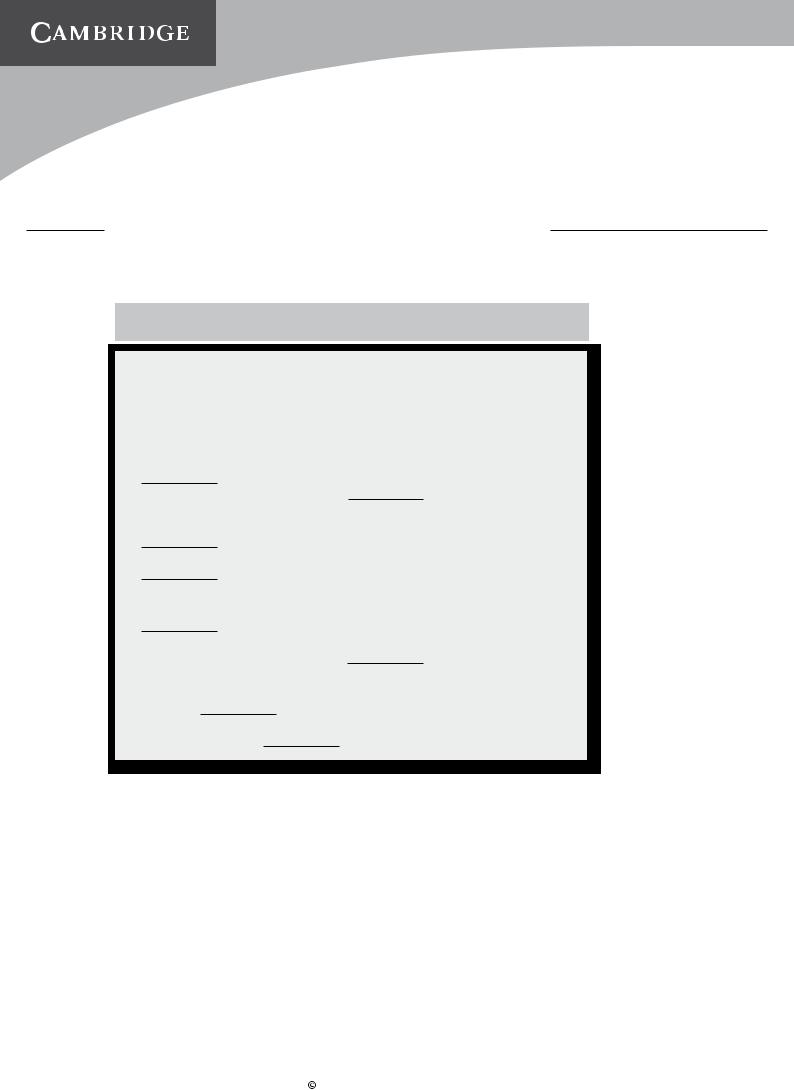
Professional English
Cambridge English for
Engineering
TEACHER’S NOTES
UNIT 9 Theory and practice
 Resource sheet 9a
Resource sheet 9a
Use the words below to complete the textbook extract about fluid dynamics.
aerodynamic door drag efficient gas liquid motion power slippery turbulence velocity wind
In everyday English, the word fluid is used to describe (1) |
|
liquid |
substances. |
|||||
In physics and engineering, a fluid can be either a liquid or a (2) |
|
|
|
. |
||||
Fluid dynamics refers to the study of fluids in (3) |
|
|
i.e. how they |
|||||
behave when they move, or when objects are moved through them. |
|
|
|
|||||
One of the major applications of fluid dynamics is in (4) |
|
|
|
|
design – |
|||
|
|
|
|
|||||
the study of how objects affect / are affected by a flow of air, either when moving through the air, or when subjected to a flow of air – e.g. due to the
(5)blowing around them. One of the main considerations in
aerodynamics is assessing how much (6) (air resistance) a vehicle or aircraft generates as it moves through the air. Designs that generate very little drag are said to be aerodynamically
(7). In general terms, minimizing drag means having a shape which allows air to flow around it as ‘cleanly’ as possible – i.e. with minimum
(8)(disruption to the airflow).
Generally, the faster a vehicle or aircraft is designed to travel, the more critical its aerodynamic design will be. This is because, for a given increase in
(9)(speed), there is a proportionately much greater increase
in drag. Due to this phenomenon, when vehicles or aircraft travel extremely fast, they must deliver significantly more (10) in order to increase their velocity by a relatively small amount.
In familiar language, engineers often describe aerodynamically efficient designs as being (11) ‘ ’, inferring that they ‘slide’ through the air easily. In the automotive industry, aerodynamically inefficient cars are often described as being ‘like a barn (12) ’.
|
Cambridge English for Engineering |
Cambridge University Press 2008 |
|
|
115 |
Photocopiable |
|||
www.cambridge.org/elt/englishforengineering |
||||
|
|
|||
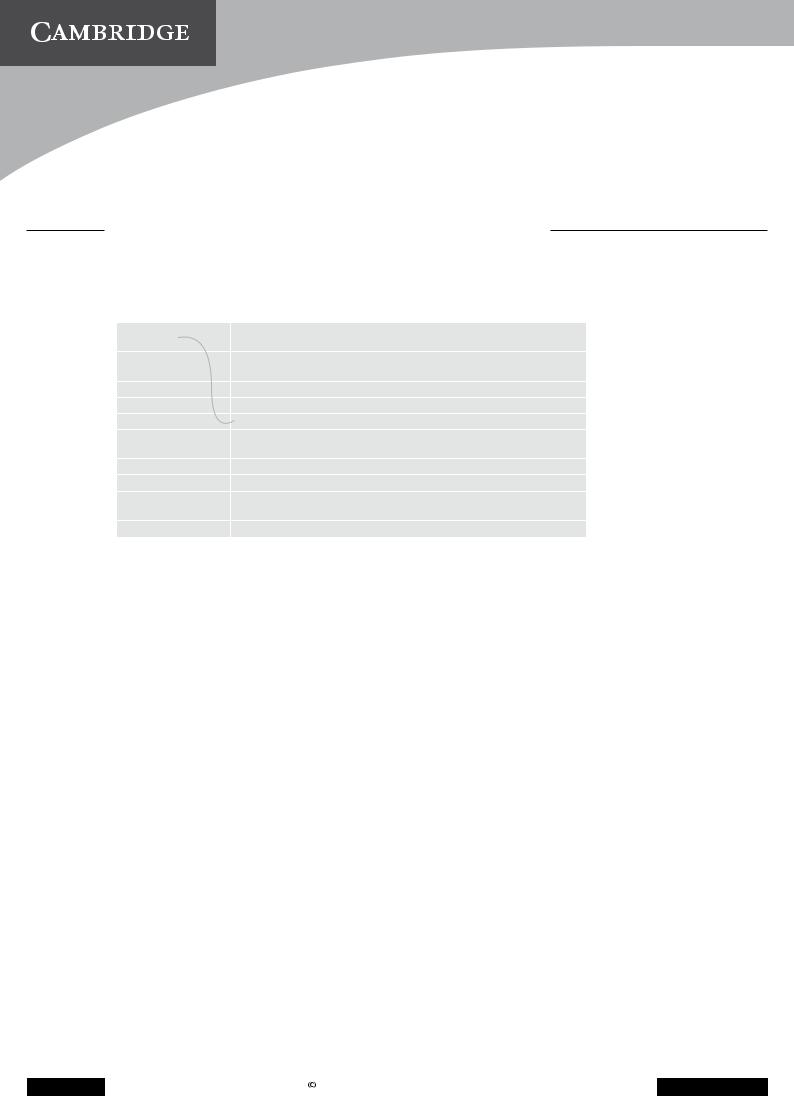
Professional English
Cambridge English for
Engineering
TEACHER’S NOTES
UNIT 9 Theory and practice
 Resource sheet 9b
Resource sheet 9b
The terms in 1–10 are useful for describing the behaviour of rockets. Match them to the definitions in a–j.
1 |
blast-off |
a |
an object’s resistance to acceleration or deceleration, increases as the |
|
mass of the object increases |
||
|
|
|
|
2 |
drag |
b |
describes an object which has the highest proportion of its mass |
|
located towards its upper end |
||
|
|
|
|
3 |
in freefall |
c |
downward force exerted by the earth’s mass |
4 |
gravity |
d |
a pushing force |
5 |
inertia |
e |
the moment a rocket launches from the ground |
6 |
powerless |
f |
descending towards the ground, with no force counteracting the descent |
|
except aerodynamic resistance |
||
|
|
|
|
7 |
thrust |
g |
aerodynamic resistance |
8 |
top-heavy |
h |
the path taken by a moving object |
9 |
trajectory |
i |
the way the total mass of an object is divided/positioned within the |
|
volume of the object |
||
|
|
|
|
10 |
weight distribution |
j |
has no means of propulsion |
116 |
Cambridge English for Engineering |
Cambridge University Press 2008 |
Photocopiable |
|
www.cambridge.org/elt/englishforengineering |
||||
|
|
|||
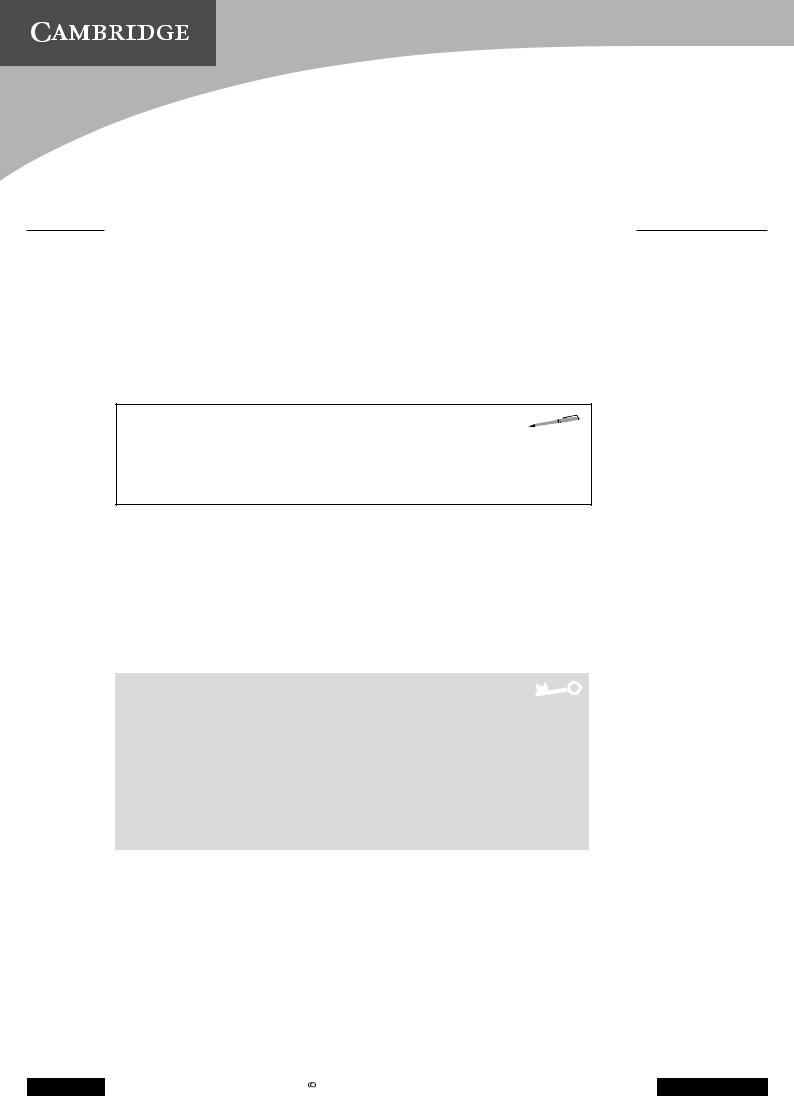
Professional English
Cambridge English for
Engineering
TEACHER’S NOTES
UNIT 10 Pushing the boundaries
•Discussing performance and suitability
•Describing physical forces
•Discussing relative performance
•Describing capabilities and limitations
 Go to page 125 for essential background information and useful web links.
Go to page 125 for essential background information and useful web links.
 Discussing performance and suitability
Discussing performance and suitability
Language note
You will find the following vocabulary useful in this section. adequate/inadequate, appropriate/inappropriate, consistent/inconsistent, economical/uneconomical, effective/ineffective, cost-effective, efficient/inefficient, reliable/unreliable, sufficient/insufficient, suitable/unsuitable
Before you begin …
Ask students to explain what is meant by pushing the boundaries (= trying to do things that have never been done before). Ask for some examples of engineering projects that have pushed the boundaries. Ask students to explain what is meant by performance (= how well something performs) and suitability (= how suitable something is for the job). Explain that to explore questions of performance and suitability this section looks at the design of wind turbines.
1 a Students complete the task in pairs.
Suggested answers
1They use the kinetic energy, movement of the wind, to generate electricity.
2Advantage: They use a renewable, non-polluting energy source that is readily available.
Disadvantages: The wind is not constant, so wind turbines cannot function all the time. They also have a major visual impact due to their height and size, and are relatively noisy.
3Locations exposed to the wind, such as high ground, flat areas and coastal areas
117 |
Cambridge English for Engineering |
Cambridge University Press 2008 |
Photocopiable |
|
www.cambridge.org/elt/englishforengineering |
||||
|
|
|||

UNIT 10 Pushing the boundaries Teacher’s Notes
b Students complete the task in pairs.
Suggested answers
The blades turn due to the airflow generated by the wind. To function,
they need to have a specially designed aerodynamic profile. They must also be stiff, to avoid flexing and consequently hitting the tower, and relatively light to allow them to turn easily.
The tower must be rigid, to resist the bending force generated by the pressure of the wind. It must also have a relatively narrow profile, to minimise the aerodynamic effect it has on the blades. When a blade is in the low position,
aligned with the tower, the pressure of the wind on the blade is reduced, reducing effectiveness, and causing torsion in the turbine due to differential pressure on the higher and lower blades.
The turbine generates electricity from the action of spinning. To function effectively, it needs to minimise friction. It must also resist the severe weather which is common in the areas where wind turbines are located.
2 a |
10.1 Students listen and answer the questions. |
Answers
1The tower
2Corrosion due to the presence of saltwater
3Steel and reinforced concrete
4Because in reinforced-concrete coastal defences, the steel reinforcement is often exposed, due to erosion, and rusts as a result
5That just because an installation requires regular maintenance, that doesn’t necessarily mean it’s unreliable
6A comparison of the difference between the construction cost of a reinforcedconcrete tower and the cost of repainting a steel tower over the period of a concrete tower’s lifespan
b Students match the words and definitions.
Answers
1 b 2 e 3 c 4 a 5 f 6 d
Pronunciation focus
Ask students to underline the stressed syllable in the following words and practise saying the words.
adequate, appropriate, consistent, economical, effective, cost-effective, efficient, reliable, sufficient, suitable
c Students complete the task.
Answer |
|
|
|
2 |
inappropriate |
6 |
inefficient |
3 |
inconsistent |
7 |
unreliable |
4 |
uneconomical |
8 |
insufficient |
5 |
ineffective |
9 |
unsuitable |
|
|
|
|
d 10.1 Students listen again and answer the question.
Answers
See audioscript 10.1 on page 94
118 |
Cambridge English for Engineering |
Cambridge University Press 2008 |
Photocopiable |
|
www.cambridge.org/elt/englishforengineering |
||||
|
|
|||
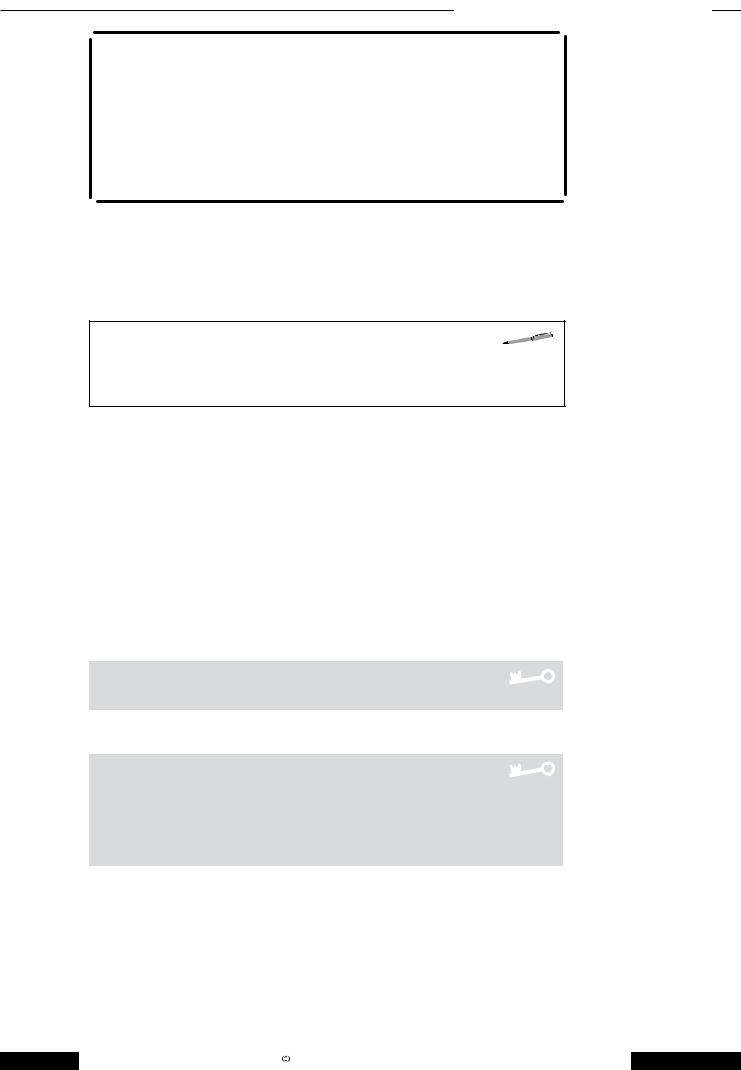
UNIT 10 Pushing the boundaries Teacher’s Notes
Extension activity: language from Exercise 2b (Resource sheet 10a)
Give students Resource sheet 10a. Students complete the conversations.
Answers |
|
|
|
|
|
2 |
inappropriate |
6 |
effective |
10 |
uneconomical |
3 |
sufficient |
7 |
unreliable |
11 |
reliable |
4 |
ineffective |
8 |
inefficient |
12 |
efficient |
5 |
insufficient |
9 |
cost-effective |
|
|
3a b
Students complete the extract.
Students complete the task in pairs.
 Describing physical forces
Describing physical forces
Language note
You will find the following vocabulary useful in this section.
bending, centrifugal force, compression, contraction, expansion, friction, pressure, shear, tension/torque
4a b
c
d
Before you begin …
Ask students to explain what is meant by force (= a push or pull). What effect do forces have on objects? They cause them to move, deform (= change shape or both). Explain that to explore different types of force that are fundamental in engineering, this section looks at an unusual project being planned in Australia which aims to push the boundaries in both structural engineering and green energy.
Students read the article and answer the question.
Students answer the question. At this stage, they could describe the forces using non-technical language, for example crushing, stretching, sliding, twisting, wobbling.
 10.2 Students listen and answer the question.
10.2 Students listen and answer the question.
Answer
She doesn’t mention centrifugal force.
Students label the diagrams.
Answers |
|
|
|
2 |
bending |
7 |
shear |
3 |
torsion/torque |
8 |
friction |
4 |
expansion |
9 |
contraction |
5 |
pressure |
10 |
centrifugal force |
6 |
tension |
|
|
119 |
Cambridge English for Engineering |
Cambridge University Press 2008 |
Photocopiable |
|
www.cambridge.org/elt/englishforengineering |
||||
|
|
|||
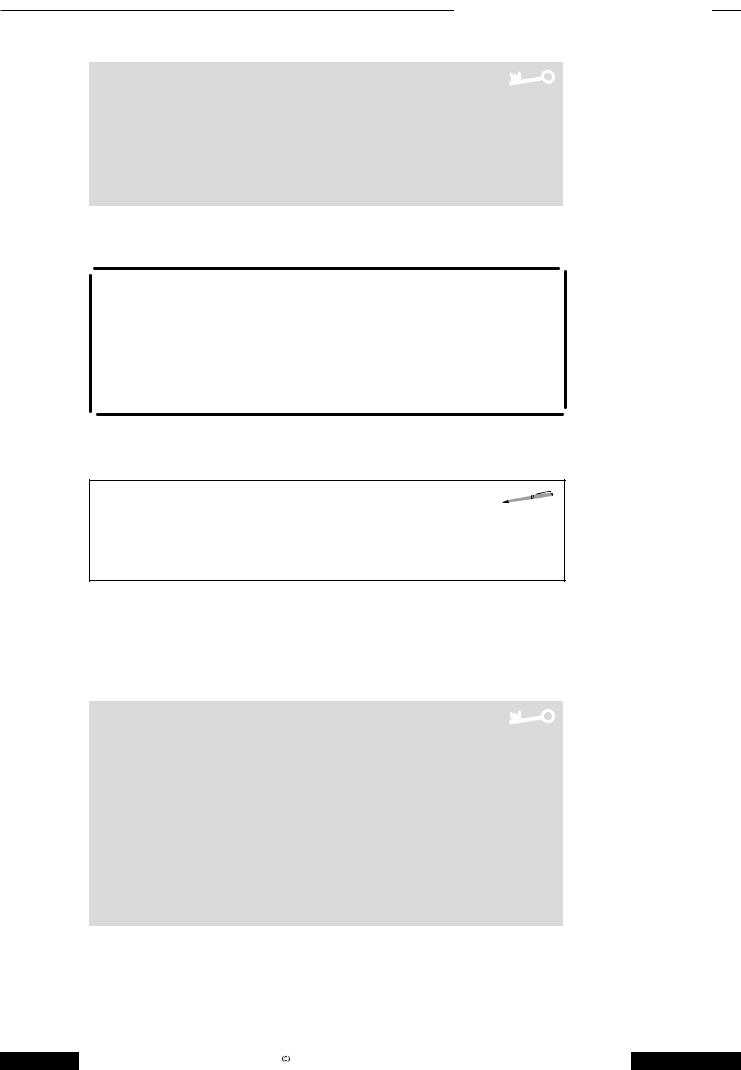
UNIT 10 Pushing the boundaries Teacher’s Notes
e  10.2 Students complete the extracts and listen again to check their answers.
10.2 Students complete the extracts and listen again to check their answers.
Answers
2pressure
3bending
4compression; tension
5shear
6friction
7torsion (torque)
8expansion; contraction
f Students complete the task in pairs. Resource sheet 10b accompanies the diagram on page 81 to help students with the task.
Extension activity: forces (Resource sheet 10c)
Resource sheet 10c is a further consolidation exercise on forces.
Answers |
|
|
|
|
|
2 |
mass |
6 |
magnitude |
10 |
compress |
3 |
accelerate |
7 |
area |
11 |
elongation |
4 |
velocity |
8 |
stress |
12 |
strain |
5 |
gravity |
9 |
deform |
|
|
 Discussing relative performance
Discussing relative performance
Language note
You will find the following vocabulary useful in this section. consideration, criterion/criteria, factor, variable
by a ... margin, to a ... extent, by a ... amount
considerably, marginally, much (more/less), significantly, slightly, substantially
Before you begin …
Ask students to explain what is meant by relative (= compared with something else). Explain that to focus on the language used when describing relative performance in engineering applications, this section looks at high-speed trains.
5 a Students complete the task in pairs.
Suggested answers
Planes travel much faster than high-speed trains. The fastest high-speed
trains can travel at just over 300 km/h. Commercial aircraft flying at an altitude of around 30,000 feet can travel with a groundspeed of around 800 km/h. Therefore, on board trips are typically faster on planes. However, rail networks generally link city centres, which are often more convenient destinations than out- of-town airports. Planes also tend to be delayed more often than trains, due to air traffic congestion at airports. Large aircraft cannot take off and land immediately after one another due to the need for separation distances for safety, and to allow air turbulence time to clear along the runway after each take-off and landing. Also, checking in for flights takes longer than boarding trains. For these reasons, overall journey times on high-speed trains can be as short as, or shorter than, those on planes over distances of 500 km to 1,500 km.
120 |
Cambridge English for Engineering |
Cambridge University Press 2008 |
Photocopiable |
|
www.cambridge.org/elt/englishforengineering |
||||
|
|
|||
